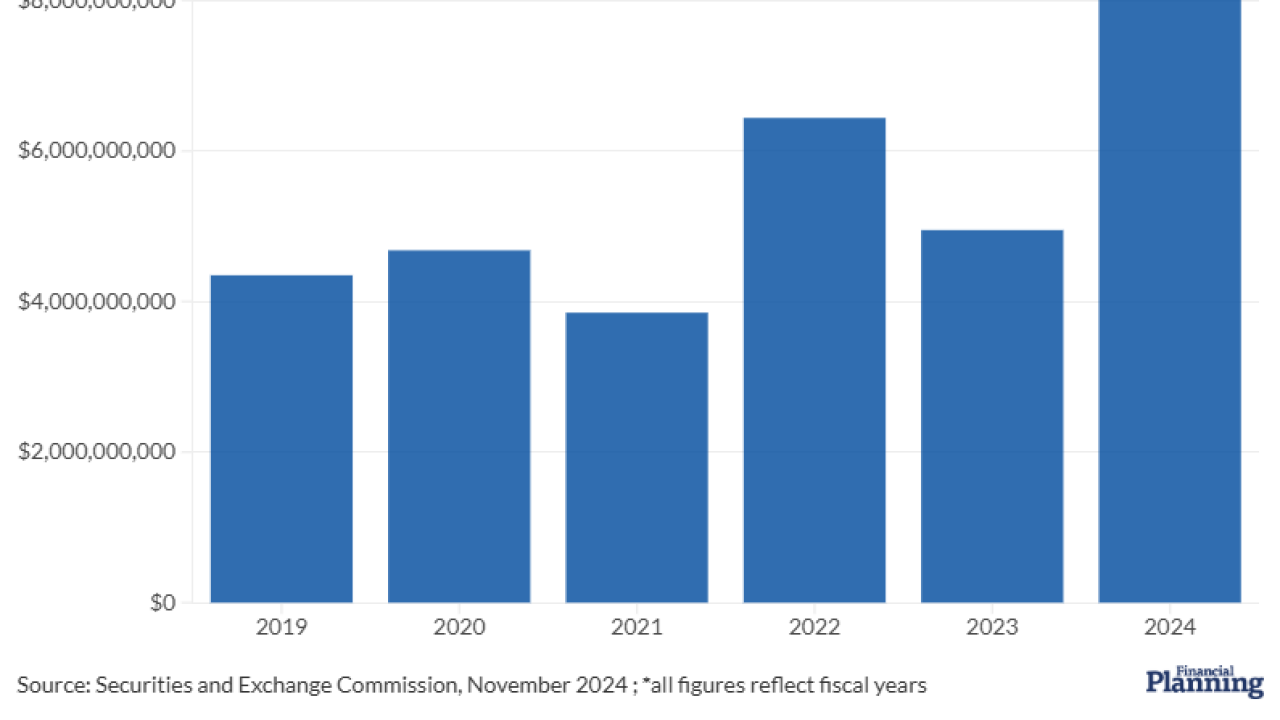Two of the most influential organizations in the world of independent planners, the CFP Board and NAPFA, do not agree on the definition of one of the most hot-button terms in the profession: fee-only.
And the split between the two groups may complicate both compliance and branding for numerous financial advisors.
We recognize there is a discrepancy between CFP Boards definition of fee only and NAPFAs fee only membership criteria, Marilyn Mohrman-Gillis, the boards managing director of public policy and communication, wrote in an email.
In short, she said, the two articulations of fee only serve different purposes, given that the CFP Board regulates its certificants for compliance while NAPFA uses fee-only to assess membership qualifications.
DISCREPANCY EMERGES
The discrepancy became clear following a
Since then, both the CFP Board and NAPFA have acknowledged that there are some NAPFA members -- the exact number is unclear but a NAPFA executive said could be about 125 -- who cannot publicly call themselves fee-only without running afoul of the CFP Board.
Its a startling development, say some advisors, given that NAPFA has always held itself out as an exclusive club of fee-only planners. That is news to me, actually, because my understanding is you have to be fee-only to be a NAPFA member, said NAPFA member Alfred McIntosh, of McIntosh Capital Advisors in Los Angeles, upon hearing of this group of planners.
NAPFAs new chief executive, Geoffrey Brown, said he believes the discrepancy would affect no more than 5% of NAPFAs 2,500-strong membership -- but that percentage could be higher or lower pending further discussion with our membership, Brown wrote in an email.
AFFILIATED ORGANIZATIONS A KEY ISSUE
The split centers on whether planners may publicly call themselves fee-only at the same time that they are affiliated with any other organization that receives any income, such as commission, that does not fall under the fee-only definition as set forth by the CFP Board.
NAPFA members are permitted to hold ownership stakes of less than 2% in broker-dealers, banks or other financial institutions, Brown said.
The CFP Board, by contrast, uses a narrower definition: Certificants may not call themselves fee-only if their employers or any other related parties receive commission income, according to the board.
In the past, NAPFA used to allow its members to have ownership stakes of up to 5% in financial firms like banks and broker-dealers, Brown said, but the group lowered the threshold in 2004. An ownership stake of that size is too small to be of concern and threaten a fee-only status, he added.
Say I get purchased by a much larger firm that has a variety of business lines, he explained, but I am still primarily fee-only. But Im connected to this larger entity. We looked at 2% as a very insubstantial stake. The actual NAPFA member is still only engaged in financial planning.
Another murky area surrounds securities and insurance licenses. NAPFA members may also hold such licenses, but must declare, I have those licenses, but I dont engage in those practices, Brown said.
The CFP board would decide on a case-by-case basis whether certificants with securities and insurance licenses could call themselves fee-only, according to Mohrman-Gillis.
IMPORTANT DISTINCTION
The definition is critical to advisors in part because the fee-only label is an effective marketing tool. Consumers are often
Yet the policy split could have serious consequences. If the CFP Board decides one of its certificants has misused the term, a sanction can be a blow to a career. After the board decided to investigate its then-chairman,
Goldfarb was ultimately sanctioned for describing his compensation as, first, fee-only and later as salary on the FPAs website. Though he received fees from clients, he was also drawing a salary from his then-employer, Weaver Wealth Management, whose parent company also owns a broker-dealer in which Goldfarb owned a 1% stake.
SPLIT BETWEEN PARTNERS
The dispute also comes as a surprise because the CFP Board and NAPFA, along with the FPA, are partners in the Financial Planning Coalition -- whose mandate is to help promote the development of the profession in legislative and other realms. (An FPA spokesman declined to discuss its definition of fee-only, but said the groups leadership is discussing the matter.)
Incoming NAPFA chairwoman Linda Leitz emphasized the importance of agreement between the coalitions member groups.
I think eventually you shouldnt be able to look at the NAPFA site and CFP site and FPA site and see people listed differently as fee-only, she said. That is something that the Financial Planning Coalition is very much in earnest working on.
Goldfarb, who is a longstanding member of the FPA and has never been a NAPFA member, says he thinks the CFPs clarified definition will affect many members of the FPA.
I would guess the vast majority of the FPA members are hybrid planners, even if they are only doing planning on a fee-only basis, Goldfarb said. The CFP Board is basically saying the only way you can be a fee-only planner is if you are an owner of an RIA, he added.
FUTURE AGREEMENT?
According to Mohrman-Gillis, NAPFA and the CFP Board are working closely together to ensure that any CFP professionals in NAPFA who fall under the 2% de minimus exception fully understand and comply with the boards compensation disclosure obligations.
In time, the CFP Board may be willing to explore how the coalitions three member organizations could agree on a single fee-only definition, she added.
When pressed on how she thinks differing definitions of such an important term might affect an already confused marketplace, however, she paused for several moments and then said, I cant comment on that.
And until theres agreement, Brown argued, the varying definitions are causing no harm to the public.
I think all of the definitions are very clear about how a fee-only advisor is compensated, he said. At [their] very essence, the spirit and the intent of the definitions are one and the same.
Read more:





